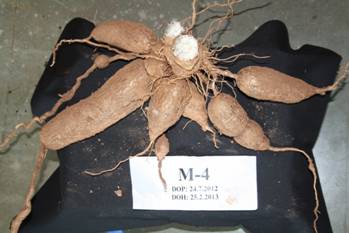
Crop: Cassava
Scientific name : (Syn:Tapioca) Manihot esculenta (Crantz) (2n=2x=36) (Hindi:Maravuli) Family:Euhorbiaceae
Common / Local Name :
Cassava is the most important starchy root crop grown in the tropics and is mainly cultivated in southern penninsular India. Introduced during seventeenth century by Portuguese, the crop played a significant role to overcome food shortage among the low-income group of people in Kerala. Underground tuber is rich in starch and mainly consumed after cooking. Processed products like chips, sago and vermicelli made of tapioca are also popular in the country. Being easily digestible, it forms and important ingredient in poultry and cattle-feeds. It is also widely used for production of industrial alcohol, starch and glucose.
Land is ploughed or dug properly for loosening soil to a depth of 20-25 cm. Depending on texture of soil and slope of land, mounds or ridges or raised beds are prepared. Mounds of 25-30 cm height are prepared in poorly drained soils. Ridges of 25-30 cm length are made in sloppy land for a rainfed crop and in levelled for irrigated crop. Ridges are taken across the slope. Flat raised beds are taken in level lands having good drainage. Since cassava mosaic disease is a serious problem, care should be taken to select disease-free stakes for preparation of sets. Raising sets initially in raised beds by planting very close (400 sets/m2), roguing out diseased plants and uprooting disease-free sets for planting at 3 weeks age ensure disease-free seedlings.
Sets of 25-30 cm length are planted vertically in beds, mounds or ridges to a depth of 5 cm. Care should be taken to avoid planting of sets inverted. Spacing depends on branching pattern of varieties. Normally erect and non-branching varieties are planted at 75 x 75 cm and branching or semi-branching varieties at 90 x 90 cm. In case, sets are dried after planting, replace it with sets of longer size, as early as possible. At time of planting, 5 % of stakes may be planted as reserve in field, separately at a closer spacing of 4 x 4 cm for gap filling after 20-25 days.

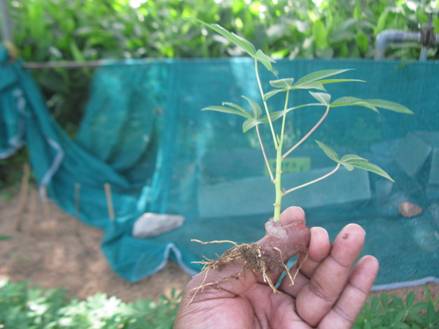
Varieties differ in colour of rind and flesh, size of tubers, colour of stem, leaf and petiole, branching pattern, duratin of crop and resistance to mosaic disease. High amount of cross-polination results in heterozygous nature. Vegetative method of propagation resulted in development of a number of polyploid varieties and hybrids. Most of the crop improvement works on cassava are done at the Central Tuber Crops Research Institute (CTCRI), Thiruvananthapuram. Important varieties developed at CTCRI are given below.
Sree Harsha: This is a triploid clone developed by crossing a diploid with an induced tetraploid clone of ‘Sree Sahya�? plants are stout, erect and non-branching with tubers f good cooking quality and high starch content (38-41%); yield 35-40 t/ha in 10 months.
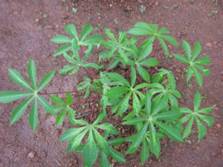
Sree Jaya: Thuis is a short-duration (6 months) clonal selection suitable for low land cutivation as a rotation cro in a paddy-based inter-cropping system; tubers are with brown skin and purple rind and have good cooking quality�? yield 26-30 t/ha; susceptible to CMD.

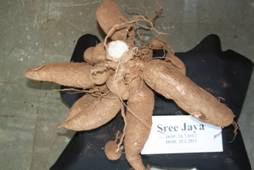
Sree Vijaya: This is also a short-duratin (6-7f months) clonal selection suitble fow low land cultivated as a rotation crop in a paddy-based intercropping system; tubers are with cream coloured rind and light fyellow flesh due to high carotene; susceptible to mite and scale insect;yield 25-28 t/ha in 7 months.
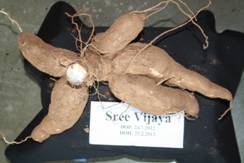
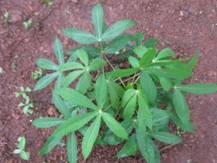
M-4: This is a non-branching varity with excellent cooking, quality; susxceptible to mites; yield 18-23 t/ha in 10 months.
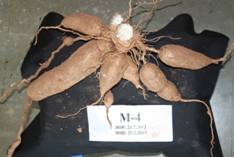
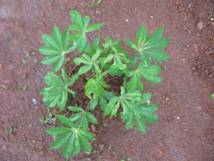
Kalpaka (KMC-1): Yield (28.4 t/ha), short duratin (6 months), non branching stem, pink tuber rind.
Cassava is a heavy feeder and crop is to be adequately manured for getting high yield. Apply 125 tonnes of farmyard manure/ha as basal dose. For high yielding varieties, a fertilizer dose of 50 kg N, 50 kg P202, and 50 kg K2O/ha is recommended at the time of land preparation. If planting of sets is done during hot condition, basal dose of fertilizers and manures may be postponed to one month after planting. This will avoid attack of termites and drying up of sets. Apply second dose of fertilizer i.e. 50 kg N and 50 kg K20, 45-50 days after planting along with weeding and earthing up. In short duration varieties, fertilizer dose can be reduced to 75:50-:75 kg NPK/ha.
Cassava is grown mainly as a rainfed crop in Kerala and irrigated crop in Tamil Nadu. Irrigating crop at 25 % avilable moisture depletion level, could double tuber yield compared to irrigated crop.
Interculture operations are aimed at removing weeds in early stages of crop and to improve physical condition of sets ffor proper tuber development. First interculture operation may be done sufficiently deep at 45-60 days after planting and a shallow interculture by way of weeding or earthing up may be given one month after the first.
Two groups of spider mites occur during dry season from January to May. One group Tetramycychus cinnabarinus and T. neocaledonicus feed on under surface of leaves causing elongated streaks, chlorosis and withering of leaves. In severe cases, it covers the upper surface also. The other group Eutetramychus orientalis and Oligonychus biharensis feed on upper surface of leaves causing depletion of chlorophyll, resulting in typical rusted leathery appearance. Curling of leaves starting from margins is also noticed. Water spray at run-off level, spraying neem oil or demethoate (0.05 %) is effective for control of mites.
Scale insect (Anoidomytellus albus) attack stem when stacked and occasionally in field causing drying. Storing of stem in vertical position and spraying dimethoate (0.05 %) will be effective for control of insect.
Termites (Odontotermes obesus) and white grubs (Leucopholis coneophora) infest roots causing drying up of plants. In severe cases, follow soil application of insecticides.
Cassava Mosaic Disease is the most serious problems of cassava cultivation in Kerala and is caused by gemini virus. Infested plants show reduction in leaf size and stunted growth, curling and ypical mosaic pattern. Though quality is not reduced, yield reductin is considerable. Field sanittion, selectin of disease free stem for planting, timely rogyuing, control of vector (white fly-Bemmisia tabaci), growing tolerant varieties like H-97, H-65, Sree Vaiskham and Sree Sahya are recommended for reducing disease incidence.
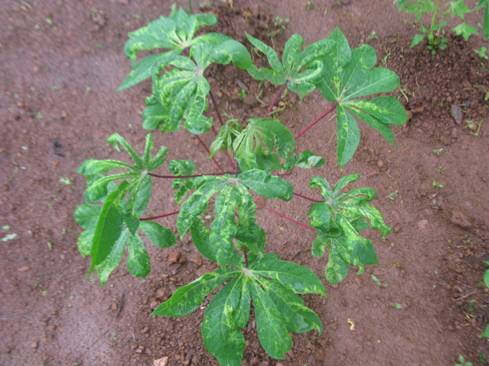 Mosaic in cassava
Mosaic in cassava
Tuber rot caused by Phytophthora dreschleri. This is more in ill-drained soils, infected tubers show brown discolouration of internal tissues and become rotten and emit foul smell. Remove infected tubers and apply Trichoderma spp.
Crop is ready for harvesting in 10-11 months after planting. Short duration varieties can be harvested in 6-7 months. Delayed harvest results in deterioratin of quality of tubers. Harvesting is usually done by uprooting plants gently by holding stem. After harvesting, stack stems vertically in well aerated place for use in subsequent lanting.
Yield is 25-30 t/ha for short duration varieties and 30-40 t/ha for other varieties.

Input availability |
Address/Contact details |
| Seeds |
|
Fertilizers |
|
Pesticides |
|
| Machineries |
|
|